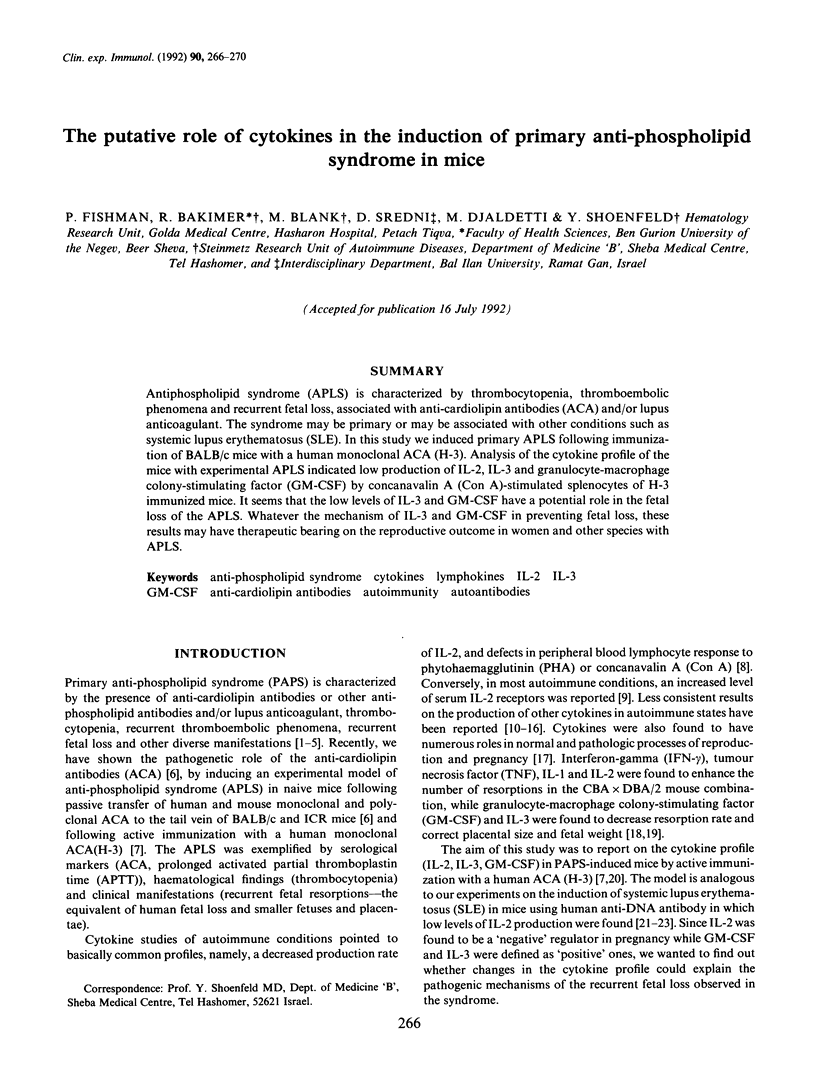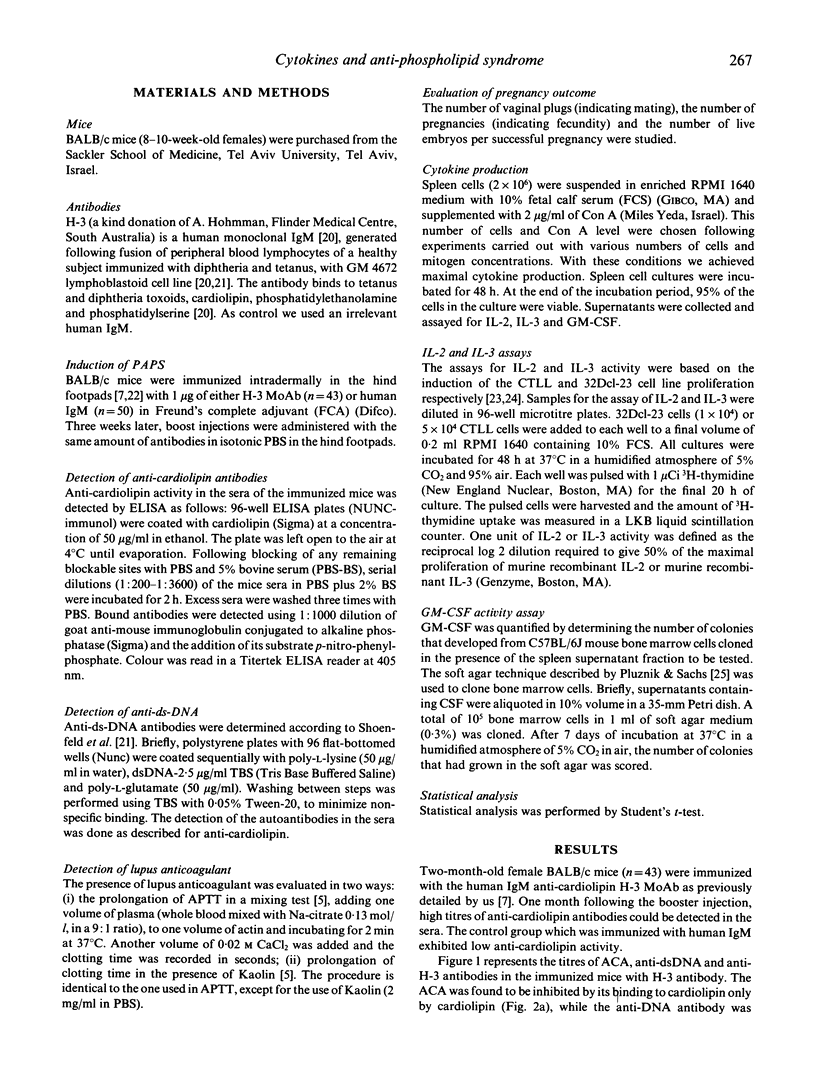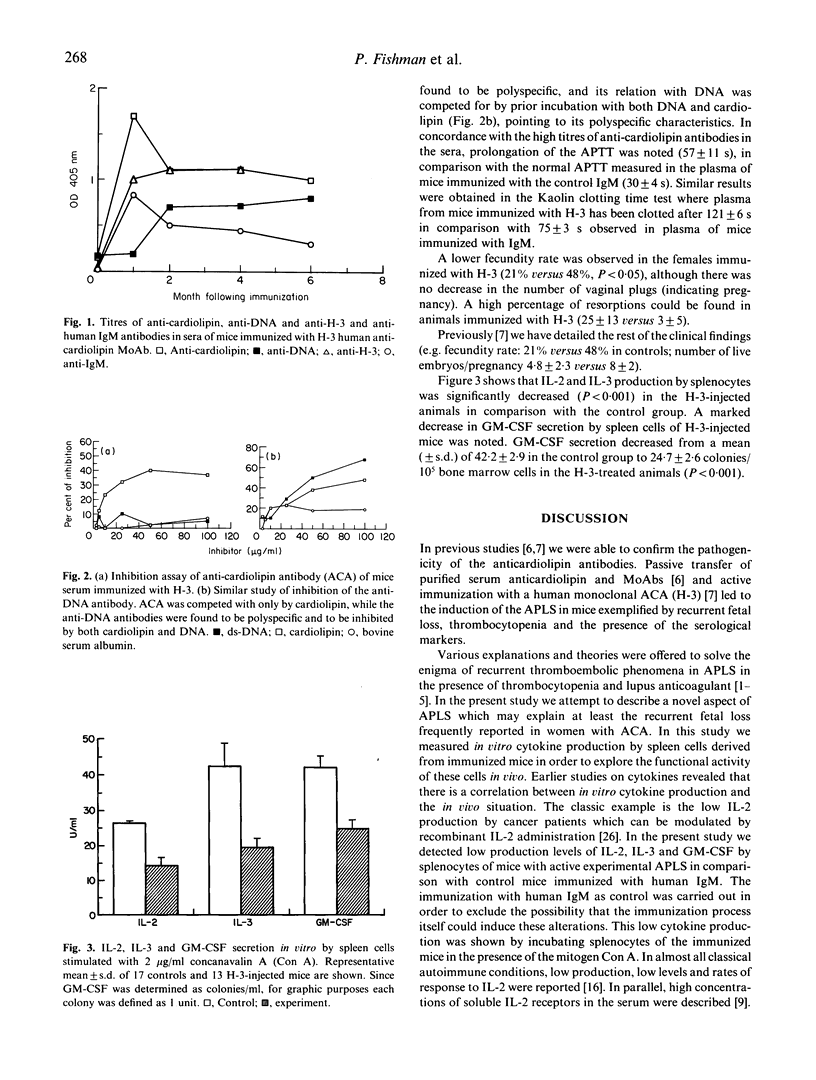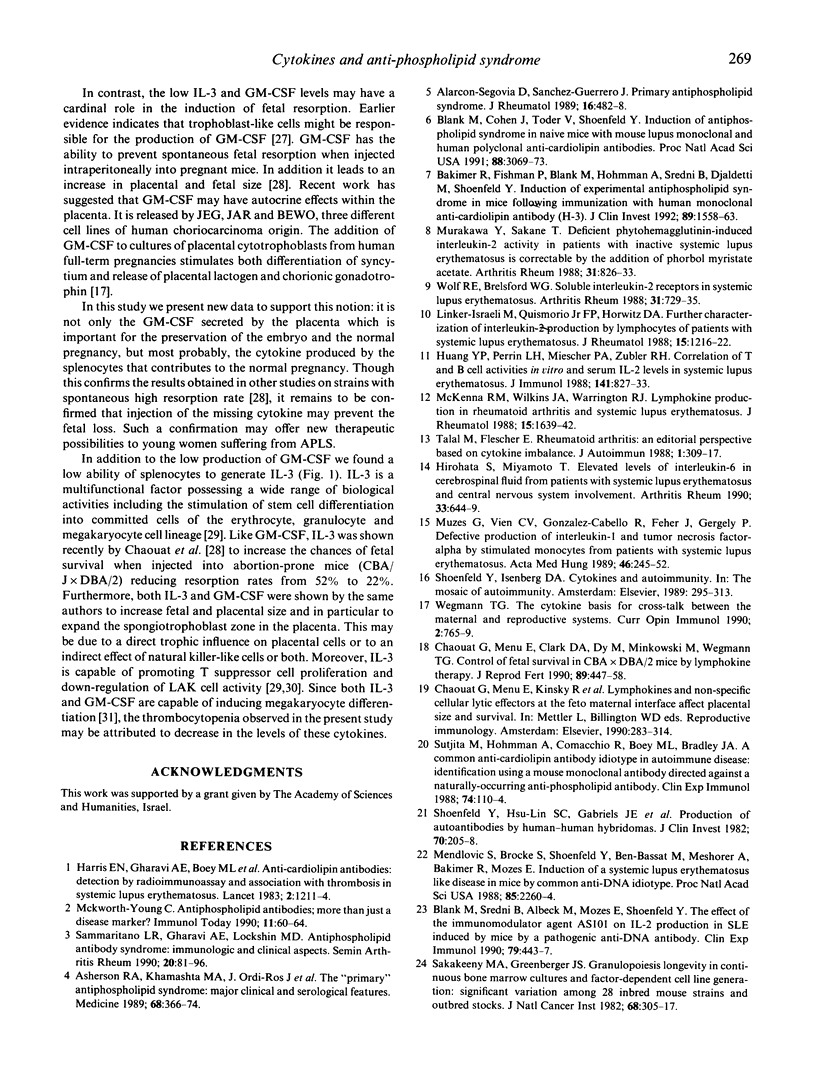Abstract
Antiphospholipid syndrome (APLS) is characterized by thrombocytopenia, thromboembolic phenomena and recurrent fetal loss, associated with anti-cardiolipin antibodies (ACA) and/or lupus anticoagulant. The syndrome may be primary or may be associated with other conditions such as systemic lupus erythematosus (SLE). In this study we induced primary APLS following immunization of BALB/c mice with a human monoclonal ACA (H-3). Analysis of the cytokine profile of the mice with experimental APLS indicated low production of IL-2, IL-3 and granulocyte-macrophage colony-stimulating factor (GM-CSF) by concanavalin A (Con A)-stimulated splenocytes of H-3 immunized mice. It seems that the low levels of IL-3 and GM-CSF have a potential role in the fetal loss of the APLS. Whatever the mechanism of IL-3 and GM-CSF in preventing fetal loss, these results may have therapeutic bearing on the reproductive outcome in women and other species with APLS.
Full text
PDF




Selected References
These references are in PubMed. This may not be the complete list of references from this article.
- Alarcón-Segovia D., Sanchez-Guerrero J. Primary antiphospholipid syndrome. J Rheumatol. 1989 Apr;16(4):482–488. [PubMed] [Google Scholar]
- Armstrong D. T., Chaouat G. Effects of lymphokines and immune complexes on murine placental cell growth in vitro. Biol Reprod. 1989 Mar;40(3):466–474. doi: 10.1095/biolreprod40.3.466. [DOI] [PubMed] [Google Scholar]
- Asherson R. A., Khamashta M. A., Ordi-Ros J., Derksen R. H., Machin S. J., Barquinero J., Outt H. H., Harris E. N., Vilardell-Torres M., Hughes G. R. The "primary" antiphospholipid syndrome: major clinical and serological features. Medicine (Baltimore) 1989 Nov;68(6):366–374. [PubMed] [Google Scholar]
- Bakimer R., Fishman P., Blank M., Sredni B., Djaldetti M., Shoenfeld Y. Induction of primary antiphospholipid syndrome in mice by immunization with a human monoclonal anticardiolipin antibody (H-3). J Clin Invest. 1992 May;89(5):1558–1563. doi: 10.1172/JCI115749. [DOI] [PMC free article] [PubMed] [Google Scholar]
- Blank M., Cohen J., Toder V., Shoenfeld Y. Induction of anti-phospholipid syndrome in naive mice with mouse lupus monoclonal and human polyclonal anti-cardiolipin antibodies. Proc Natl Acad Sci U S A. 1991 Apr 15;88(8):3069–3073. doi: 10.1073/pnas.88.8.3069. [DOI] [PMC free article] [PubMed] [Google Scholar]
- Blank M., Sredni B., Albeck M., Mozes E., Shoenfeld Y. The effect of the immunomodulator agent AS101 on interleukin-2 production in systemic lupus erythematosus (SLE) induced in mice by a pathogenic anti-DNA antibody. Clin Exp Immunol. 1990 Mar;79(3):443–447. doi: 10.1111/j.1365-2249.1990.tb08109.x. [DOI] [PMC free article] [PubMed] [Google Scholar]
- Chaouat G., Menu E., Clark D. A., Dy M., Minkowski M., Wegmann T. G. Control of fetal survival in CBA x DBA/2 mice by lymphokine therapy. J Reprod Fertil. 1990 Jul;89(2):447–458. doi: 10.1530/jrf.0.0890447. [DOI] [PubMed] [Google Scholar]
- Chaouat G., Menu E., Clark D. A., Dy M., Minkowski M., Wegmann T. G. Control of fetal survival in CBA x DBA/2 mice by lymphokine therapy. J Reprod Fertil. 1990 Jul;89(2):447–458. doi: 10.1530/jrf.0.0890447. [DOI] [PubMed] [Google Scholar]
- Fishman P., Sredni B., Djaldetti M. Recent advances in interleukin-3 research: a review. Isr J Med Sci. 1990 Jul;26(7):414–419. [PubMed] [Google Scholar]
- Gallagher G., Wilcox F., al-Azzawi F. Interleukin-3 and interleukin-4 each strongly inhibit the induction and function of human LAK cells. Clin Exp Immunol. 1988 Nov;74(2):166–170. [PMC free article] [PubMed] [Google Scholar]
- Harris E. N., Gharavi A. E., Boey M. L., Patel B. M., Mackworth-Young C. G., Loizou S., Hughes G. R. Anticardiolipin antibodies: detection by radioimmunoassay and association with thrombosis in systemic lupus erythematosus. Lancet. 1983 Nov 26;2(8361):1211–1214. doi: 10.1016/s0140-6736(83)91267-9. [DOI] [PubMed] [Google Scholar]
- Hirohata S., Miyamoto T. Elevated levels of interleukin-6 in cerebrospinal fluid from patients with systemic lupus erythematosus and central nervous system involvement. Arthritis Rheum. 1990 May;33(5):644–649. doi: 10.1002/art.1780330506. [DOI] [PubMed] [Google Scholar]
- Huang Y. P., Perrin L. H., Miescher P. A., Zubler R. H. Correlation of T and B cell activities in vitro and serum IL-2 levels in systemic lupus erythematosus. J Immunol. 1988 Aug 1;141(3):827–833. [PubMed] [Google Scholar]
- Ichikawa K., Shimada K., Nawata Y., Ishii T., Tomioka H., Yoshida S., Koike T. Monoclonal hybridoma anti-cardiolipin antibodies from SLE mice. Clin Exp Immunol. 1988 Oct;74(1):110–114. [PMC free article] [PubMed] [Google Scholar]
- Linker-Israeli M., Quismorio F. P., Jr, Horwitz D. A. Further characterization of interleukin-2 production by lymphocytes of patients with systemic lupus erythematosus. J Rheumatol. 1988 Aug;15(8):1216–1222. [PubMed] [Google Scholar]
- Mackworth-Young C. Antiphospholipid antibodies: more than just a disease marker? Immunol Today. 1990 Feb;11(2):60–65. doi: 10.1016/0167-5699(90)90020-a. [DOI] [PubMed] [Google Scholar]
- McKenna R. M., Wilkins J. A., Warrington R. J. Lymphokine production in rheumatoid arthritis and systemic lupus erythematosus. J Rheumatol. 1988 Nov;15(11):1639–1642. [PubMed] [Google Scholar]
- Mendlovic S., Brocke S., Shoenfeld Y., Ben-Bassat M., Meshorer A., Bakimer R., Mozes E. Induction of a systemic lupus erythematosus-like disease in mice by a common human anti-DNA idiotype. Proc Natl Acad Sci U S A. 1988 Apr;85(7):2260–2264. doi: 10.1073/pnas.85.7.2260. [DOI] [PMC free article] [PubMed] [Google Scholar]
- Murakawa Y., Sakane T. Deficient phytohemagglutinin-induced interleukin-2 activity in patients with inactive systemic lupus erythematosus is correctable by the addition of phorbol myristate acetate. Arthritis Rheum. 1988 Jul;31(7):826–833. doi: 10.1002/art.1780310702. [DOI] [PubMed] [Google Scholar]
- Mũzes G., Vien C. V., González-Cabello R., Fehér J., Gergely P. Defective production of interleukin-1 and tumour necrosis factor-alpha by stimulated monocytes from patients with systemic lupus erythematosus. Acta Med Hung. 1989;46(4):245–252. [PubMed] [Google Scholar]
- Pluznik D. H., Sachs L. The cloning of normal "mast" cells in tissue culture. J Cell Physiol. 1965 Dec;66(3):319–324. doi: 10.1002/jcp.1030660309. [DOI] [PubMed] [Google Scholar]
- Rosenberg S. Lymphokine-activated killer cells: a new approach to immunotherapy of cancer. J Natl Cancer Inst. 1985 Oct;75(4):595–603. [PubMed] [Google Scholar]
- Sakakeeny M. A., Greenberger J. S. Granulopoiesis longevity in continuous bone marrow cultures and factor-dependent cell line generation: significant variation among 28 inbred mouse strains and outbred stocks. J Natl Cancer Inst. 1982 Feb;68(2):305–317. [PubMed] [Google Scholar]
- Sammaritano L. R., Gharavi A. E., Lockshin M. D. Antiphospholipid antibody syndrome: immunologic and clinical aspects. Semin Arthritis Rheum. 1990 Oct;20(2):81–96. doi: 10.1016/0049-0172(90)90021-7. [DOI] [PubMed] [Google Scholar]
- Shoenfeld Y., Hsu-Lin S. C., Gabriels J. E., Silberstein L. E., Furie B. C., Furie B., Stollar B. D., Schwartz R. S. Production of autoantibodies by human-human hybridomas. J Clin Invest. 1982 Jul;70(1):205–208. doi: 10.1172/JCI110595. [DOI] [PMC free article] [PubMed] [Google Scholar]
- Shoenfeld Y., Teplizki H. A., Mendlovic S., Blank M., Mozes E., Isenberg D. A. The role of the human anti-DNA idiotype 16/6 in autoimmunity. Clin Immunol Immunopathol. 1989 Jun;51(3):313–325. doi: 10.1016/0090-1229(89)90030-5. [DOI] [PubMed] [Google Scholar]
- Talal N., Flescher E. Rheumatoid arthritis: an editorial perspective based on cytokine imbalance. J Autoimmun. 1988 Aug;1(4):309–317. doi: 10.1016/0896-8411(88)90001-7. [DOI] [PubMed] [Google Scholar]
- Teramura M., Katahira J., Hoshino S., Motoji T., Oshimi K., Mizoguchi H. Clonal growth of human megakaryocyte progenitors in serum-free cultures: effect of recombinant human interleukin 3. Exp Hematol. 1988 Nov;16(10):843–848. [PubMed] [Google Scholar]
- Wegmann T. G. The cytokine basis for cross-talk between the maternal immune and reproductive systems. Curr Opin Immunol. 1989;2(5):765–769. doi: 10.1016/0952-7915(90)90048-l. [DOI] [PubMed] [Google Scholar]
- Wolf R. E., Brelsford W. G. Soluble interleukin-2 receptors in systemic lupus erythematosus. Arthritis Rheum. 1988 Jun;31(6):729–735. doi: 10.1002/art.1780310605. [DOI] [PubMed] [Google Scholar]


